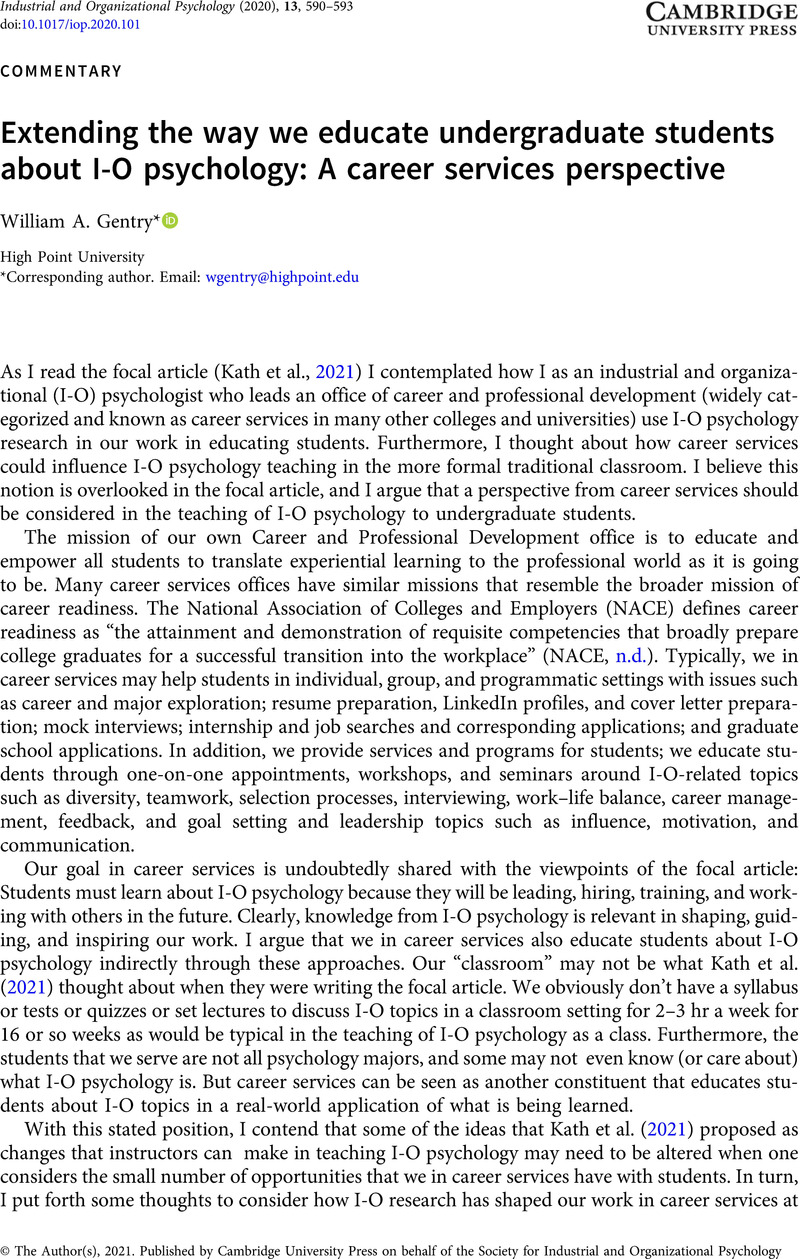No CrossRef data available.
Article contents
Extending the way we educate undergraduate students about I-O psychology: A career services perspective
Published online by Cambridge University Press: 08 February 2021
Abstract
An abstract is not available for this content so a preview has been provided. Please use the Get access link above for information on how to access this content.

- Type
- Commentaries
- Information
- Copyright
- © The Author(s), 2021. Published by Cambridge University Press on behalf of the Society for Industrial and Organizational Psychology
References
Allen, T. D. (2003). Mentoring others: A dispositional and motivational approach. Journal of Vocational Behavior, 62, 134–154.CrossRefGoogle Scholar
Allen, T. D., Poteet, M. L., & Burroughs, S. M. (1997). The mentor’s perspective: A qualitative inquiry and future research agenda. Journal of Vocational Behavior, 51, 70–89.CrossRefGoogle Scholar
Allen, T. D., Poteet, M. L., Russell, J., & Dobbins, G. H. (1997). A field study of factors related to supervisors’ willingness to mentor others. Journal of Vocational Behavior, 50, 1–22.CrossRefGoogle Scholar
Allen, T. D., Russell, J. E. A., & Maetzke, S. B. (1997). Formal peer mentoring: Factors related to protégés’ satisfaction and willingness to mentor others. Group & Organization Management, 22, 488–507.CrossRefGoogle Scholar
Ardts, J. C. A., van der Velde, M. E. G., & Maurer, T. J. (2010). The influence of perceived characteristics of management development programs on employee outcomes. Human Resource Development Quarterly, 21, 411–434.CrossRefGoogle Scholar
Bouloutian, A. (2009). There is a lot more to training than training. Talent D
evelopment, 63(12), 40–45.Google Scholar
Burke, L. A., & Hutchins, H. M. (2007). Training transfer: An integrative literature review. Human Resource Development Review, 6, 263–96.CrossRefGoogle Scholar
Burke, R. J., & McKeen, C. A. (1989). Developing formal mentoring programs in organizations. Business Quarterly, 53(3), 76–79.Google Scholar
Cunningham, J. B. (1993). Facilitating a mentorship programme. Leadership & Organization Development Journal, 14(4), 15–20.CrossRefGoogle Scholar
Dobrow, S. R., Chandler, D. E., Murphy, W. M., & Kram, K. E. (2012). A review of developmental networks: Incorporating a mutuality perspective. Journal of Management, 38, 210–242.CrossRefGoogle Scholar
Eddy, E., Tannenbaum, S., Alliger, G., D’Abate, C., & Givens, S. (2001). Mentoring in industry: The top 10 issues when building and supporting a mentoring program. Technical report prepared for the Naval Air Warfare Center Training Systems Division (Contract No. N61339-99-D-0012).Google Scholar
Gentry, W. A. (2015). Mentoring for leadership development. In Riddle, D. D., Hoole, E. R., & Gullette, E. C. D. (Eds.), The Center for Creative Leadership handbook of coaching in organizations (pp. 347–382). Jossey-Bass.CrossRefGoogle Scholar
Gentry, W. A., Allen, L. W., Wolf, A. K., Manning, L., & Hernez-Broome, G. (2011). Coach and client characteristics that Asian and European coaches believe are needed for effective coaching engagements. International Journal of Mentoring and Coaching, 9(2), 56–79.Google Scholar
Gentry, W. A., Eckert, R., Munusamy, V. P., Stawiski, S. A., & Martin, J. (2014). The needs of participants in leadership development programs: A qualitative and quantitative, cross-country investigation. Journal of Leadership & Organizational Studies, 21, 83–101.CrossRefGoogle Scholar
Ghosh, R., Haynes, R. K., & Kram, K. E. (2013). Developmental networks at work: Holding environments for leader development. Career Development International, 18, 232–256.CrossRefGoogle Scholar
Higgins, M. C., & Kram, K. E. (2001). Reconceptualizing mentoring at work: A developmental network perspective. Academy of Management Review, 26(2), 264–288.CrossRefGoogle Scholar
Kath, L., Salter, N., Bachiochi, P., Brown, K., & Hebl, M. (2021). Teaching I-O psychology to undergraduate students: Do we practice what we preach? Industrial and Organizational Psychology: Perspectives on Science and Practice, 13(4), 443–460.Google Scholar
Murphy, W. M., & Kram, K. E. (2014). Strategic relationships at work: Creating your circle of mentors, sponsors, and peers for success in business and life. McGraw Hill Companies.Google Scholar
National Association of Colleges and Employers (NACE). (n.d.). Career readiness defined. Retrieved from http://www.naceweb.org/career-readiness/competencies/career-readiness-defined/
Google Scholar
Ragins, B. R., & Scandura, T. A. (1999). Burden of blessing? Expected costs and benefits of being a mentor. Journal of Organizational Behavior, 20, 493–509.3.0.CO;2-T>CrossRefGoogle Scholar
Roszkowski, M. J., & Soven, M. (2010). Did you learn something useful today? An analysis of how perceived utility relates to perceived learning and their predictiveness of satisfaction with training. Performance Improvement Quarterly, 23, 71–91.CrossRefGoogle Scholar
Scaduto, A., Lindsay, D., & Chiaburu, D. S. (2008). Leader influences on training effectiveness: Motivation and outcome expectation processes. International Journal of Training and Development, 12, 158–170.CrossRefGoogle Scholar
Smith-Jentsch, K. A., Scielzo, S. A., Yarbrough, C. S., & Rosopa, P. J. (2008). A comparison of face-to-face and electronic peer-mentoring: Interactions with mentor gender. Journal of Vocational Behavior, 72, 193–206.CrossRefGoogle Scholar
Tannenbaum, S. I., Mathieu, J. E., Salas, E. & Cannon-Bowers, J. A. (1991). Meeting trainees’ expectations: The influence of training fulfillment on the development of commitment, self-efficacy, and motivation. Journal of Applied Psychology, 76, 759–769.CrossRefGoogle Scholar
Tyler, K. (April, 1998). Mentoring programs link employees and experienced executives. HR Magazine, 43(5), 98–103.Google Scholar


